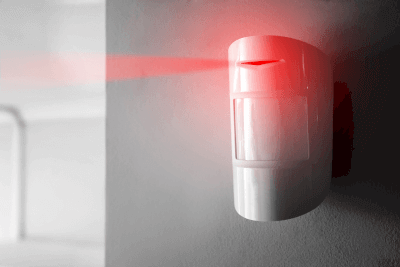What Is a Through-Beam Sensor?

A through-beam sensor is a type of sensor that detects objects by emitting a beam of light.
These sensors utilize visible light, infrared light, and laser light as their light beams. They are capable of detecting the intrusion or movement of people, objects, the location of objects, steps, and more.
Uses of Through-Beam Sensors
Through-beam sensors are widely used in various industries such as factories, residences, parking lots, offices, hospitals, and solar power plants. In the semiconductor and electronics industries, ultra-compact sensors are typically used for detecting bumps and lifts, positioning, detecting the presence or absence of machined holes, component positioning, tip detection, and confirming the arrival of boards.
In hospitals, they are used to signal nurses when a patient leaves the bed. In garages, the sensors can activate patrolling lights or similar systems to notify when someone passes through an entrance or exit. They also play a role in safety, such as reversing and opening doors that are about to close.
For night surveillance of premises, the system triggers a warning alarm when someone enters a specific area. These sensors are also used for detecting intruders in material storage areas and in alarm systems when a vehicle exceeds a specified height limit.
Principle of Through-Beam Sensors
A through-beam sensor comprises a light emitter that emits a light beam, a light receiver, a power supply, and an amplifier. The light beam is either blocked, transmitted, or reflected by an object, causing a change in the amount of light detected by the receiver. This change is then converted into an output signal.
The light sources can be of various colors, including infrared, red, green, blue, and a combination of red, green, and blue. Output circuits may include NPN transistor open collector, PNP transistor open collector, DC 2-wire, NPN transistor universal, relay contact, and other contact outputs. Another common type is the analog output via analog voltage.
Characteristics of Through-Beam Sensors
1. Non-contact Detection
Through-beam sensors enable non-contact detection from a distance, meaning they are not affected by the mounting of the sensor. This allows for long-term, consistent detection.
2. Fast Response
The sensors provide a high-speed response due to their optical beam and fully electronic circuit composition, making them suitable for high-speed production lines.
3. Long Detection Distance
Transmissive sensors are capable of detecting objects from several tens of meters away.
4. Other Advantages
These sensors can detect various colors as differences in light intensity, due to the varying reflection/absorption ratios of specific light wavelengths. They offer high-precision detection, with optics and electronic circuit technology enabling an accuracy of up to 20 µm.
However, a drawback of beam sensors is that dust and dirt accumulation on the lens surface may hinder proper light emission or reception, leading to malfunctions.
Types of Through-Beam Sensors
Through-beam sensors come in various types, depending on their detection method and configuration.
1. Classification by Detection Form
Transmissive, mirror-reflective, and reflective types are common methods for projecting and receiving light. Additionally, there are compact, fiber-type sensors that utilize optical fibers.
Transmissive Type
In this type, the light emitter and receiver are installed separately. Detection occurs when an object interrupts the light beam. Both components require a power supply. This type offers a long detection distance.
Mirror-Reflective Type
Here, the light emitter and receiver are integrated into a single unit, while a separate reflective mirror is used to detect changes in light reflected due to an object or person. This type is less expensive than the transmissive type and can be used over long distances.
Reflective Type
In the reflective type, the light emitter and receiver are integrated. It captures light reflected off an object or person. However, this type has a shorter detection distance and is more susceptible to interference from colors.
2. Classification by Configuration
Through-beam sensors are classified into built-in or separate electronic circuit configurations. Available types include amplifier built-in, power supply built-in, amplifier separate, fiber type, and more. The choice depends on installation space, power supply, and noise immunity considerations.
Amplifier built-in and power supply built-in types can provide non-contact output or relay contact output. In the amplifier separate type, the light-emitting and receiving elements are distinct from the amplifier, allowing for a smaller sensor section. Adding a DC power supply enables non-contact output.
The fiber type connects an optical fiber to the light-emitting and receiving elements in the amplifier body, with the detection end being separate. Light is projected and received through the optical fiber, offering excellent environmental resistance.